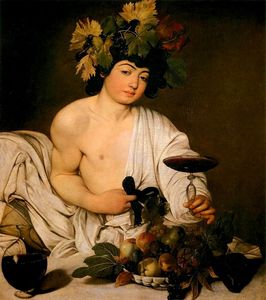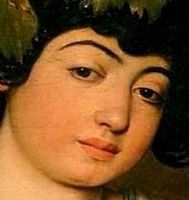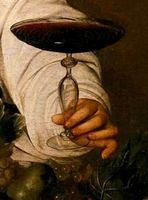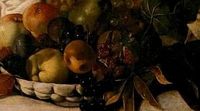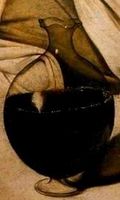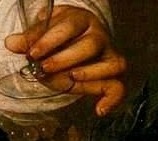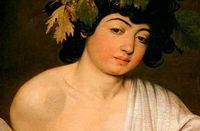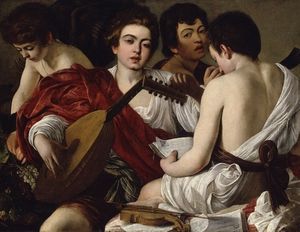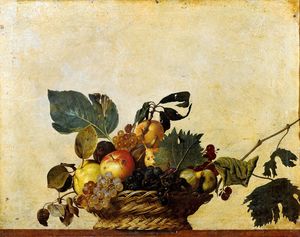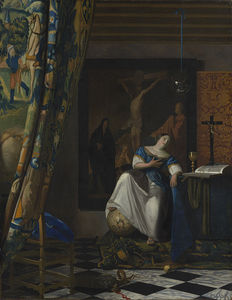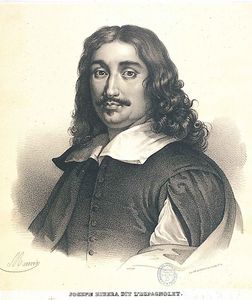Bacchus
- Date of Creation:
- 1595
- Height (cm):
- 95.00
- Length (cm):
- 85.00
- Medium:
- Oil
- Support:
- Canvas
- Subject:
- Figure
- Art Movement:
- Baroque
- Created by:
- Current Location:
- Florence, Italy
- Displayed at:
- Galleria degli Uffizi
- Owner:
- Galleria degli Uffizi
Bacchus Story / Theme
Bacchus is the Roman name for the Greek god Dionysus. This effeminate god of wine, madness and ecstasy often appears in scenes of revelry and licentiousness. In his Bacchus, Caravaggio shows the god as a seventeenth-century Italian teenager, offering the viewer wine, spoiled fruit and perhaps something more.
The basket of fruit in the Bacchus is sometimes interpreted as a vanitas. A vanitas is a type of still-life painting especially popular in Dutch and Flemish art of the Renaissance and Baroque, which is intended to remind the viewer of the fleeting nature and meaninglessness of earthly life. Common vanitas symbols include skulls, timepieces (to show that time on earth is running out), bubbles (for their fragility), and, as here, wilting flowers and rotting fruit.
Due to the way in which Bacchus' offers the wine with his left hand, which requires a great deal of effort, many have speculated that Caravaggio used a mirror to help him while working, to avoid the need for drawing.
This means that the boy actually offers the wine with his right hand. This supports a comment by artist Giovanni Baglione, Caravaggio's early biographer, that the artist did some early paintings using a mirror.
This is also reinforced by the fact that after the painting was cleaned, a tiny portrait of Caravaggio working at his easel was revealed in the glass' reflection. Also, Bacchus' reflection is evident on the surface of the wine in the glass he is holding.
Whether intentional or not, there is humor in this painting. The pink-faced Bacchus is an accurate portrayal of a half-drunk teenager dressed in a sheet and leaning on a mattress in the Cardinal's Rome palazzo, but far less convincing as a Greco-Roman god.
Bacchus Inspirations for the Work
The Bacchus was most likely commissioned by Cardinal del Monte the year after Caravaggio entered his court. Cardinal del Monte commissioned around 40 paintings from the artist, many depicting relatively effeminate, sexualized young men.
Given that the Cardinal was also known to throw dinner parties where young men would dress up as women, today many suspect that del Monte had homosexual tendencies.
The subjects of this period in Caravaggio's career were mostly adolescent boys, as in The Young Bacchus and The Musicians. These early pictures reveal a fresh, direct, and empirical approach.
Bacchus Analysis
As was generally the case with Caravaggio's works, Bacchus is striking for the artist's careful attention to realistic detail.
Composition:
One of art historians' favorite topics when discussing Caravaggio's Bacchus is the still-life of fruit in the foreground. The artist's early years painting fruits and flowers for the Caveliere d'Arpino definitely paid off, as the Caravaggio's mastery of still-life elements shines brilliantly.
Like the dirty fingernails, many have wondered if this basket of bruised, overripe, wormy fruits could also have a symbolic message, such as a warning of the fleetingness of youth and the eminence of death, or if Caravaggio was just painting what he truly saw.
After the Bacchus was restored, conservators discovered that Caravaggio even painted in a tiny reflection of himself on the carafe of wine. Once again, the careful observer can spot the familiar face of the model who is probably Mario Minniti, who can also be seen in The Fortune Teller as well as several other early paintings.
Although the purported subject of this painting is a Greek god, Caravaggio makes no effort to uphold the illusion. The model's vaguely antique toga is recognizable as a contemporary men' s shirt pulled down over one shoulder, and the artist even shows the dirty mattress peeking out under a none-too-clean sheet.
Color palette:
Caravaggio has carefully depicted his model's "farmer's tan": the skin of his chest and upper arms is pale and white, while his face and hands are ruddy and red. As in many other paintings, Caravaggio shows even the dirt under his models' fingernails.
Some have interpreted the Bacchus' dirty fingernails as a symbolic warning of the consequences of physical pleasure. In the wider context of Caravaggio's oeuvre, however, it could just be realism plain and simple.
Bacchus Critical Reception
Famous art historian Donald Posner was the first to publish an in-depth study on the homoerotic implications of Caravaggio's early paintings, including the Bacchus. This has proved to be one of the biggest quarrels amongst historians when discussing Caravaggio's works: in an age where sodomy was a crime punishable by death, would any artist in his right mind execute an overtly homoerotic work and would a patron actually pay for it? Are we mistakenly seeing this late sixteenth-century painting through modern eyes?
Regardless of the critical debate, any objective viewer would be able to pick up on the erotic overtones in the Bacchus. The young man (who, of course, is intended to represent the god of drunkenness and debauchery) gazes knowingly at the viewer while his garment has fallen flirtatiously off his shoulder. He proffers a glass of wine and thus, by extension, may be proffering something more.
Even acknowledging the potential homoeroticism of the Bacchus, however, no ultimate judgment can be made about the sexuality of Caravaggio or of Cardinal del Monte.
Bacchus Related Paintings
Bacchus Artist
In 1595, Caravaggio's career received a boost from the influential Cardinal del Monte as he welcomed the artist into his court. Caravaggio executed paintings for the Cardinal and took advantage of his connections to garner prime commissions from Rome's wealthiest patrons and collectors.
Caravaggio's works at this time focused on effeminate young men, as seen in Bacchus, although he also started to create religious scenes. His paintings were complex and became darker during this period.
Caravaggio was as controversial for his revolutionary artworks as he was for his infamous temper and lengthy police record. He ignored the rules that artists from the previous century had followed and instead developed a love of realism and his emotional directness was unrivalled.
Caravaggio's paintings constitute some of the most stunning works in the entire history of Western art. Observing the evolution of his style from his early works such as Bacchus to his last paintings is a chronicle of his life.
Caravaggio played a key role in defining 17th century Italian art. In the 20th century when emerging artists were adopting his techniques and imitating his style. Caravaggism had profound effects on the art world and artists that were directly and indirectly influenced by Caravaggio include Rubens, Hals, Rembrandt, Vermeer, Velazquez and Bernini.
Bacchus Art Period
The Baroque style originated in Italy and its pioneers include great artists such as Michelangelo and Tintoretto. Baroque art focused on impersonal and generic works with an animated and energetic mood. The success of this art genre was promoted by the Roman Catholic Church and the aristocracy, the latter of which saw Baroque art as a means of demonstrating wealth and power.
Caravaggio is a pioneer of the Italian Baroque style that grew out of the ruins of Mannerism. At the end of the 16th century, the artist was exposed both to the artistic reforms of the Counter-Reformation as well as to a new interest in scientific naturalism flourishing in northern Italy, due in part to the influx of artworks from northern Europe.
Out of this context, Caravaggio developed a style of unflinching realism, unprecedented approachability and a direct appeal to the emotions that had no equal among his peers and helped to mould 17th century Italian art.
Italian Baroque art was not widely different to Italian Renaissance painting but the color palette was richer and darker and the theme of religion was more popular. There remains some mystery surrounding the true derivation of Italian Baroque but some argue that the word 'Baroque' comes from the Italian "Barocco".
Caravaggio's influence is evident both directly or indirectly in the paintings artist such as of Rubens, Bernini, Jusepe de Ribera and Rembrandt, and the next generation of artists profoundly influence by Caravaggio were labeled the "Caravaggisti" or "Caravagesques", as well as Tenebrists or "Tenebrosi" ("shadowists").
Bernard Berenson agreed: "With the exception of Michelangelo, no other Italian painter exercised so great an influence".
Bacchus Bibliography
To read more about Caravaggio and his works please refer to the recommended reading list below.
• Bernedetti, Sergio. Caravaggio: The master revealed. Dublin: The National Gallery of Ireland, 1993
• Freedberg, S. J. Circa 1600:A revolution in the style of Italian painting. Cambridge, Mass. : Harvard University Press, 1983
• Friedlander, Walter. Caravaggio Studies. New York: Schocken Books, 1969
• Gilbert, Creighton. Caravaggio: his two Cardinals. University Park: Pennsylvania State University Press, 1995
• Hibbard, Howard. Caravaggio. New York: Harper and Row, 1983
• Hinks, R. P. Michelangelo Merisi da Caravaggio: His life, his legend, his works. London: Faber & Faber, 1953
• Langdon, Helen. Caravaggio: A life. New York: Farrar, Straus & Giroux, 1999
• Mancini, Giulio, Giovanni Baglione, and Giovanni Bellori. Lives of Caravaggio. London: Pallas Athene, 2005
• Moir, Alfred. Caravaggio. New York: H. N. Abrams, 1989
• Varriano, John. Caravaggio: the art of realism. University Park: Pennsylvania State University Press, 2006

